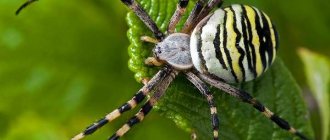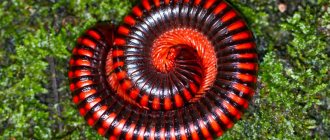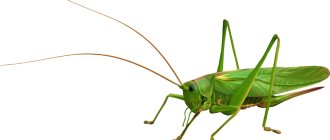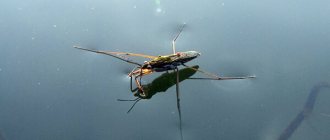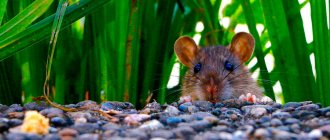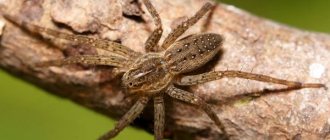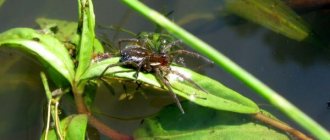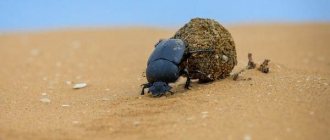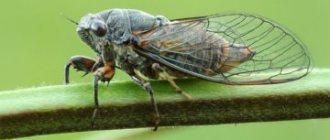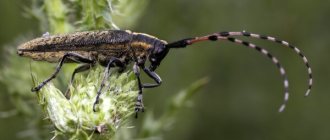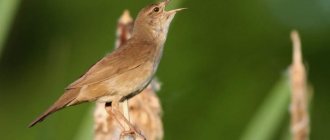With the onset of spring across the entire vast territory of Russia, along with the joy of blossoming buds and the first snowdrops, a familiar problem appears - the ixodid tick (lat. Ixodidae). The common people have the frightening name “encephalitis”, i.e. ticks that carry encephalitis. A more correct name for several types of ticks that bother people and animals is the dog tick or forest tick. The pasture tick also belongs to this category. Ticks appear in the spring, when the snow cover has not yet completely melted, and go into hibernation in late autumn with the onset of frost. But this does not mean that they are active throughout the warm season. To understand periods of tick activity, you should turn to biology.
Types of ixodid ticks
Ticks belong to the order Arthropods, not insects. Closest relatives are crabs. A distinctive feature is the presence of four pairs of legs, not three. This family of arthropods includes more than 650 species distributed throughout the world.
Ixodid ticks are found even in the Arctic and Antarctic, parasitizing penguins and Arctic birds. Some species are carriers of dangerous infections - encephalitis, borreliosis and a whole bunch of other, no less dangerous, infections. The most dangerous types of ixodid ticks in terms of their distribution are:
- Forest or taiga tick – Ixodes persiucatus
- Dog tick – Ixodes ricinus
- Meadow or pasture tick – Dermacentor reticulatus.
The latter does not belong to ixodid ticks, but to a different subtype, but recently its spread, as well as the similar biology and the danger of the infections it carries, has caused serious concern among specialists. All these types of mites are parasitomorphic.
Tick-borne borreliosis
The infectious disease also develops against the background of infection due to a parasite bite. Lyme disease develops gradually. The damage affects joint tissues, nerve plexuses and heart muscle. If detected at an early stage, the pathology can be easily eliminated by prescribing antibiotics. The infection is dangerous because it can be transmitted from pet to person and from person to person.
The causative agents of the disease are considered to be spirochete microorganisms, the carriers of which are ixodid ticks. From the moment the insect attaches itself, the incubation period ranges from 7 to 14 days, during which the malaise does not have pronounced signs. The danger of infection is that any delay in treatment can lead to disability.
Lyme disease has two common forms: symptomatic and asymptomatic. In the latter case, signs of infection can be identified only by the results of laboratory tests.
In the case of the manifest form, the patient notes the active progression of symptoms. First, weakness occurs throughout the body, accompanied by muscle pain and attacks of fever. Spirochetes gradually move through nerve and joint tissues, and also infect lymph nodes. The patient begins to experience intense inflammation of the spinal cord and brain. Such pathological reactions contribute to the instability of the body's defense reactions. In this regard, relapses of the disease are possible 5 years after the end of treatment.
Follow us
Find out more about your animal's personality on our social networks
Many bacteria die as they spread through the victim’s body. The processes of endotoxin synthesis are launched, which provokes the death of skin tissue, kidney cells, joints and spleen. The largest inflammatory foci will be found in the brain area. Surviving spirochetes activate the destruction of bones and cartilage. The course of borreliosis includes three main stages. The first of them is called acute. The patient notes signs that are in many ways reminiscent of the flu: increased body temperature, general weakness, headaches and muscle pain. Such syndromes appear a week after infection and become more pronounced every day for a month.
The main indicator of infection is considered to be migrating erythrema - a light spot with a red edge, which increases in size and is located at the site of the tick bite. The papule can reach a size of 60 cm and is accompanied by cyanotic swelling. In the area of the spot, the skin becomes more sensitive and its temperature rises.
Sometimes the only symptom of infection is erythrema. Patients may notice the simultaneous formation of several erythremas in different parts of the body. In exceptional cases, Lyme disease makes itself felt only by the appearance of a feverish state and severe intoxication.
At the second stage of development of the disease, the lesion affects the heart muscle and parts of the nervous system. The patient loses sensory sensitivity, suffers from numbness in parts of the body and meningitis, painful headaches and fever. Inflammation affects the brain and its surrounding membranes, as a result of which sleep is disturbed and memory suffers. Cardiac dysfunction is expressed in rapid heartbeat and increasing pain in the heart area. The third stage of borreliosis is marked by progressive arthritis, the formation of atrophic dermatitis, and damage to the heart muscle.
The occurrence of a chronic form of borreliosis can be indicated by the appearance of red rashes in the bends of the limbs. The formations gradually increase in size and merge into a huge inflammatory focus with atrophy of the epidermis in the affected area.
Life cycle and lifestyle of the ixodid tick
The biology of tick reproduction and nutrition determines when they are more active and dangerous to humans. There are three stages of development - larva, nymph and imago (mature individual). The female is twice as large as the male and the shield on her back covers 2/3 of the body. The female, filled with blood, swells to a gray pea with a diameter of up to 11 mm.
Based on the existing analogy with blood-sucking insects, in particular mosquitoes, many believe that only the female feeds on the blood of animals; this is not entirely true. Ixodid ticks feed once for each stage. It can be not only warm-blooded animals or humans; the tick parasitizes both amphibians and birds. They move quickly, but choose the suction site carefully, from an hour to two. The female, having drunk blood, mates and then moves to the soil, laying eggs on the stems of plants. She can lay up to 3000 eggs.
The hatched larvae climb onto bushes and tall grass and wait for the victim with their front legs with hooks extended forward. In appearance, the tick larva is similar to the adult, but has a dull dark color. The larva needs nutrition for development.
After sucking on the animal’s blood, the larva hides in the forest floor, moults and turns into a “nymph.” This is an analogy to the pupa in insects, with the only difference being that the nymph is active and also requires nutrition. Full development occurs in 1-1.5 years, but can take up to 4 years. The period of starvation for larvae, nymphs and adult ticks can last up to a year.
Actions after removing the pest
Since the parasite may be a carrier of a dangerous disease, it would be ideal to send the extracted body to a laboratory for research. This must be done within two days after removal. The result of the analysis will be known within 5 hours. If you have been vaccinated against a possible bite, then you need to warn the specialist about this before the study so that the existing antibodies do not mislead him.
Each person's reaction to a bite is different. Some suffer it asymptomatically, others experience a severe allergic reaction, the face swells, muscle pain appears, and it becomes difficult to breathe. In such cases, the victim should be given an antihistamine and call a doctor immediately.
It would be correct to carry out therapeutic measures and diagnose a possible disease in a hospital setting. Treatment depends on the type of pathogen. The infection affects various important human organs and the consequences of a bite may be different from each other. In some cases, all body functions are quickly restored, in others, rehabilitation lasts up to 3 years, and can lead to a person’s incapacity.
Climatic and time preferences of ticks
As already noted, these arthropods are common in all climatic zones of the Earth, are very tolerant of temperature changes and can be in a state of starvation for a long time. But favorable conditions for reproduction determine the period of tick activity. When the air temperature rises in certain hours from 10°C, when the forest floor is heated by the sun, forest ticks emerge from hibernation.
The end of March - the beginning of April is the time when these arthropods can already be found, but night frosts and periodic cold precipitation restrain their activity. Having moved onto the body of a warm-blooded animal, the tick feels comfortable and makes an attempt to suction. Already during this period, a person should take safety measures against bites of ixodid and pasture ticks.
Periods of greatest activity
Ticks become active in early spring. Favorable conditions for their existence are considered to be an ambient temperature above 20 degrees with a humidity of 80%. Maximum activity is observed in the spring, when the parasites awaken from hibernation. During a prolonged winter, insects become more active by April. The awakening of parasites often coincides with the appearance of the first snowdrops and the swelling of green buds on the trees. As soon as the snow melts, the air warms up, arthropods gradually leave their shelters. By +10 degrees the parasites become quite active. The number of insects will be minimal after a harsh winter with severe frosts.
In which months are ixodid ticks most active?
The period of tick activity by month looks like a double sine wave - a rise from April, a peak at the end of May, then a decline and a new rise in September. As explained above, spring is the time when tick larvae and nymphs emerge from the litter to feed, as well as the breeding season of adults, which is why late spring and early summer are the most dangerous times.
See the article “Tick Season”.
The autumn peak occurs when the larvae emerge from the eggs, which occurs after 10 weeks. Taking into account the time for development and laying of eggs, the second peak occurs at the end of summer - beginning of autumn. Moreover, fall activity is higher in the European part of Russia. Siberia, with its sharp cooling, experiences this peak less acutely.
In what weather are ticks most active?
An additional condition conducive to tick activity is the weather. In what weather are ticks most active? They love warm, humid weather , wet, rainy summers, and long, cloudy springs—the most favorable time for ticks to reproduce. For example, spring came early in 2022 and ticks in the Moscow region became active ahead of time.
By planning your visits to places where there is a risk of encountering a tick, you can reduce the risks to a minimum. Schedule a time when ticks are no longer active. When the clear midday sun reduces activity, ticks hide until the evening. High temperatures and dry air inhibit ticks, but are most comfortable for outdoor recreation.
Nutrition specifics
Before starting to suck blood, the tick usually spends a long time looking for a suitable place on the host’s body. He will definitely prefer an area with delicate thin skin, so ticks are often found on the neck, behind the ears, in the groin area, and on the bends of the limbs.
Having found a successful area for a bite, the parasite rests the front part of its body against the skin and takes a position almost perpendicular to it, piercing the chelicerae. This process is not instantaneous, and the penetration of the host’s integument itself can take several tens of minutes. Gradually, the chelicerae are inserted deeper and deeper and push the wound apart from the inside, allowing the proboscis to penetrate the skin. Inside the proboscis there is a pre-oral cavity into which the salivary glands emerge, and saliva is actively secreted into the wound area.
If the tick is infected with any infection, then already at this moment the pathogens will begin to penetrate the host tissues.
A special protein component - the secretion of saliva - quickly hardens, creating an intermediate “cemented” zone between the proboscis and the tissues of the host, further securing the tick’s mouthparts in the skin. At the end of the “cement case” multiple hemorrhages and an inflammatory focus are formed, but the parasite’s saliva also contains anesthetics, and therefore the bite often goes unnoticed.
In addition, saliva contains vasodilators and components that prevent blood clotting (anticoagulants). All this is necessary to ensure successful long-term feeding of the tick.
An interesting fact is that blood sucking is not a continuous act of supplying food to the parasite’s body. During the process of blood absorption, the stages of active saturation and rest alternate. In the pre-oral cavity of the tick, thanks to the muscles of the pharynx, a vacuum is created, which acts as a pump for blood and lymph during their absorption. Having fed, the tick removes the proboscis from the body and falls off.
On a note
Ixodids have several surprising biological features that are characteristic only of some representatives. One of them, aphagia, is a phenomenon in which adult males of certain species do not feed at all, but only engage in fertilization of engorged females, after which they immediately die.
Another interesting phenomenon, characteristic only of ticks, is omovampirism, in which hungry ticks (usually males) do not hesitate to attack their well-fed relatives. They pierce the body of their fellow and suck some of the blood from it. What is noteworthy is that the victim tick remains alive after such an unceremonious intervention in its metabolic processes, and if it is a female, then she is quite capable of safely laying eggs after this.
How to protect yourself from ixodid ticks?
Having gained an understanding of what ixodid ticks are, what their way of life and reproduction is, we can protect ourselves as much as possible from the unpleasant moments of suction and, in addition, receiving a dangerous infection. You should remember basic safety measures when you are in the forest and field in the summer:
- Try not to plan a picnic or outdoor recreation during peak periods of tick activity.
- Use repellents and clothing that is good at preventing ticks from crawling underneath.
- When stopping, sit in sunny and dry areas of the area, where you are less likely to encounter ticks.
- Conduct self-examination and mutual inspection every 2 hours in the forest.
The most effective measure against infection by infections carried by ixodid ticks is preventive vaccination with an encephalitis vaccine, which is carried out a month before the time of tick activity. In the absence of vaccination, urgent vaccination with immunoglobulin is an effective measure of protection.
Content
1. Types 2. Life cycle 3. Periods of greatest activity 4. Danger to animals and people 5. Tick-borne encephalitis 6. Tick-borne borreliosis 7. How to protect yourself from infection
Walking through a forest or other open area is fraught with many dangers. By contacting grass and leaves, a pet can pick up an unwanted companion - the ixodid tick - and bring it into the house. This blood-sucking parasite belongs to the arthropod species. Its population numbers more than a thousand species. More than 70 species of parasites belonging to this group have been discovered on Russian territory alone. Ixodid ticks, carriers of diseases, begin to be most active from spring until late autumn. Their diet is the blood of animals and people, so household members should closely monitor their pet and check its body for bite marks.
What diseases do Ixodid ticks carry?
We wouldn't be so afraid of ticks if their bites were safe. But, unfortunately, ticks carry several diseases that can ruin a person’s life and health. The main diseases transmitted by ixodid ticks are listed below.
Tick-borne encephalitis
Tick-borne encephalitis is the most common disease that a tick can infect a person with. Encephalitis ticks are most common in taiga and forest zones. Every year in Russia about 500 thousand people, of which about 2000 become infected with encephalitis. Encephalitis is a focal infection that damages the central nervous system and can lead to paralysis of the limbs and other serious diseases. If you are bitten by a tick, remove it, store it in a container, and take it to a laboratory to determine whether it was contagious. If the answer is yes, start treatment immediately!
Tick-borne borreliosis, Lyme disease
Borreliosis is another dangerous tick-borne disease, also called Lyme disease. Bacteria that enter the human blood spread throughout the body and cause inflammation of internal organs, which can lead to their damage. If treatment is not started in time, the consequences can be disastrous: disruption of the cardiovascular system, organ damage, Lyme arthritis, and in the most severe cases, death.
Borreliosis infection from a tick bite can be identified by a light spot that forms around the bite, followed by a red circle. If you see such a mark after a bite, immediately consult a doctor and start treatment!
Removing the Parasite
To remove a tick at home, you need to know how to do it correctly. If a parasite is detected, it is better to consult a specialist. He will remove it and show you how to do it in the future. To remove it, you need to prepare a strong but thin thread or tweezers. To disinfect the bite site, you will need alcohol. It is better to use special devices to remove the parasite - a tick gun or a lasso handle. A needle may be needed if the pest's head comes off.
You should begin removing imagoes by treating the skin with alcohol and an oil composition. The substance will cut off his oxygen, which can force the bloodsucker to get out. If the pest does not come out, then after treating the skin you should use a special tool or tweezers.
Having captured the parasite, you should rotate it around its axis 360º and pull it up. You can twist in any direction, but only in one direction. If the parasite has not had time to attach strongly at this stage, it can be removed with a thread. The noose is thrown onto the bloodsucker at the very base. A few scrolls are enough and the pest will be removed.
You can pull it out with a syringe. To do this, the tip of the tool is cut off evenly in the area of the needle. The edges are treated with an oily substance for better sealing. The syringe is placed over the pest, and after a few seconds the piston is pulled upward. After which the tick gets out on its own. If his head comes off, it is imperative to remove it. The bleeding wound remaining after removing the tick must be disinfected.
